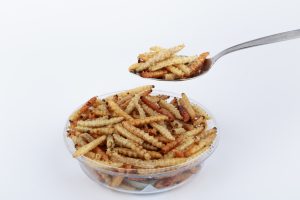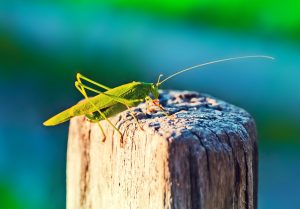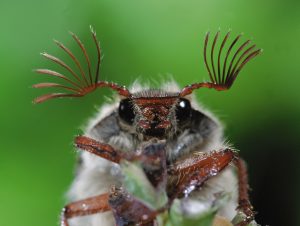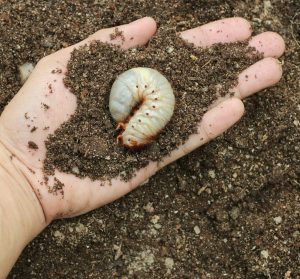
Fancy some meal worms for lunch? (image from colourbox.com)
Insect-based food for human purpose is now sold in Switzerland. Our neighbours have recently legalised the growing and sale of insects for food purposes, which makes them the first European country to do so. Since mid of August, mealworm-based burger patties and meatballs (where the term “meat” might be misleading) are offered in Swiss grocery stores. With my eyebrows raised to the max, I spontaneously thought of where I would not want to have worms present: my house, my computer, and, of course, my food. The latter is probably driven by the place where I grew up and the culture I am living in. In other parts of the world, consuming worms, grasshoppers & co is just as normal as laying down for a good night sleep. Actually, 65% of the world population eat insects on a daily basis. Sounds like yum in many people’s tum!
The proper term for eating insects is entomophagy. This phenomenon is not new, since insects have been used as food by humans from prehistoric times to the present day. To date, it looks like this topic is more up to date than ever! The taste for insects is very common in most parts of the world, including Africa, Asia, Australia and New Zealand, and also North, Central and South America. Around 80% of the world’s nations eat over 1,000 different insect species, whereas in some parts of the world, insect-eating is uncommon or even considered a taboo (please notice me waving my hand). I have never thought that I would say that, but the German “Jungle Camp” is a very proper example for this. Whoever has observed Marc Terenzi, Indira Weis, or Olivia Jones facing their creepy-crawly dinner during the show knows: The word entomophagy generates many looks of inquiry.
Around the world

Grasshoppers are considered a delicacy in many parts of the world (image from colourbox.com)
The development of insects includes a complete change of the outer appearance and is paraphrased by the enchanted word metamorphosis. Metamorphosis starts in the egg phase, where the insect-to-be then develops via larva and pupa to a mature adult. These little or sometimes not so little creatures feed on e.g. vegetables or rotten food and then, in turn, can be eaten raw, dried, pulverised or heated by cooking, boiling, frying, or roasting. What a potpourri of possibilities! In contrast to the German population, people in Asia consider insects a delicacy. The insect-menu there is extremely rich, offering dishes for both, people who like insects with or without e.g. legs. It includes grasshoppers, dragonflies, and, of course, mealworms. Here, insects are fried in a wok and then honey, lemon grass, different sauces, or selected spices are added ad libitum. Voilà – the perfect snack is arranged. At places of silk production, the larvae present in the silk-containing cocoons are also cooked and then consumed, which is actually a good example for the total use of animals without any wasting.
In Africa, around 85% of the population eats caterpillars. 100 grams of dried caterpillars contain 53 g protein and 15% fat, the energy value is 430 kilo calories. Compared to that, 100 g wiener sausage only contain 15 g protein but 26% fat, which in total represents 230 kilo calories. Furthermore, eating termites is very popular (especially when the termite queen is on the menu – yummy!), and the so-called Bushman or Hottentots rice consists of the pupae of several termite species. In some parts of America, e.g. in Mexico, insects are sometimes more expensive than meat. High-class restaurants serve cooked ant larvae together with tortillas, which is termed “Mexican caviar”. Furthermore, chocolate-dipped grasshoppers are a common desert in this country.

Well, hello there! (image from colourbox.com)
As previously mentioned, things are a little different in Europe. Round here, insects are fought with insecticides and cause disgust when brought in touch with food. This is actually funny, because many people in Germany consider crustaceans like lobster, shrimp, crabs & co delicacies. Interestingly, crustaceans are closely related to insects. The latter belong to the subphylum hexapods, which, similar to crustaceans, is a subphylum of the arthropods. This circumstance is another valid example for the fact that some borders only exist in people’s heads. Until around 100 years ago, cockchafer soup was served in Germany and France, where per meal 30 chafers were caught, rinsed, pestled, and then boiled in broth.
Meat the truth
But let’s face the actual benefit of insect-derived food: The Food and Agriculture Organization of the United Nations (FAO) has been evaluating the use of insects for food purposes with regard to the growing world population for several years. They found out that the area needed for farming could be reduced by one third if the present consume of meat was reduced by one half and substituted by food based on insects. The world population increased from 2.7 to 6 billion between 1950 and 2000 and during that time, meat production increased by a factor of 5 from 45 to 233 billion kg per year. In the future, the FAO expects a world population of 9 billion for 2050, accompanied by a meat production of 410 billion kg per year (FAO 2006, Boland et al. 2013). Major animal protein sources for human consumption include meat, fish, milk, and eggs (van der Spiegel et al. 2013) and to date, almost 40% of our total protein consumption is based on animals; a number that will keep increasing in the future. Unfortunately, production of animal-based proteins is extremely inefficient. 40-50% of the global grain harvest is used for animal feed production, where 2 to 15 kg plant material is needed to produce 1 kg of animal products (Profetas 2008). According to Gerbens-Leenes and others, people should eat less beef and more pork or chicken, reduce their portions, or, which sounds even better, switch to plant-based protein sources like legumes (Gerbens-Leenes 2000, Aiking and De Boer 2006).

You might soon find food like this in European supermarkets… (image from colourbox.com)
Since there is the urgent need for a change, novel protein sources like insects, algae, and rapeseed are expected to enter the European food market. Their food safety aspects, however, are not well-known. In general, eating insects does not cause health problems in humans (DeFoliart 1992). It is known that people regularly eat small amounts of insects unconsciously (yes, we all know that; and if not: now you know), which normally does not cause complications unless an individual reacts allergically (Mitsuhashi 2008). Interestingly, insect-derived proteins potentially cause a cross-allergenicity with shrimps and house dust mites (Witteman et al. 1994). Besides their allergenic potential, insects may also contain toxic substances. These are either self-produced defence chemicals or phytochemicals that are taken up from the food plant (Duffey 1980, Wirtz 1984). Toxic insect metabolites may be carboxylic acids, alcohols, and steroids, just to name a few. Phytochemicals include flavin, tannins, and terpenoids. However, nutritional tests in rats which were fed with silkworms revealed that they are not toxic unless a maximal dose of 1.5 g/kg body weight was consumed per day (Zhou and Han 2006). Furthermore, insects can serve as alternate hosts for some pathogens. Mealworms for example are known to carry certain tapeworm species, which aim to reach the intestine of host individuals like e.g. humans.
Today, it looks like entomophagy experiences a strong revival in Europe. In most European countries, however, insects are not approved for human consumption. Still, novel protein sources are expected to enter the European food market as replacers for animal-derived proteins rather sooner than later. One of the main reasons might be the Kyoto protocol on the global climate, where the European Union agreed on the reduction of greenhouse gas emissions. It is well known that cattle breeding and its related meat consumption are responsible for the majority of these gas emissions (Steinfeld et al 2006, Van Beukering et al. 2008). However, until now, the European law is not clear regarding the use of novel protein sources in food products. One of the major issues for food applications is whether or not products with insects are considered animal-derived products or not (van der Spiegel 2013). Insects are eukaryotic organisms that belong to the biological kingdom Animalia. Thus, I personally for sure consider them animals and since I am a vegetarian, insects will never (knowingly) appear on my menu. But I think that insect-based food might indeed represent an interesting alternative for all those (lost) carnivore souls out there who are willing to try something new. With all the climate changes in mind, one day they probably have to.
So, what is next? Algae, duckweed, in vitro meat… new taste sensations seem to be inevitable. By the way: The red colour in lipstick is called carmine and is derived from female coccids. During its preparation process, the powdered insect bodies are boiled and treated with several chemicals to purify the bright-red pigment. Thus, insect-derived products might be closer to our mouths than we currently think. But let’s be serious: I bet at least half of our readers barely read this article because they’re still fantasizing about the mealworm-based burger patties. No worries – here’s the recipe for your perfect mealworm burger: Simply buy the previously mentioned patties, burger rolls, lettuce, onions, tomatoes, and ketchup and buckle up for a new taste experience.
To say it with Katy Perry’s words: Bon a, bon appétit, baby!
References & Sources:
https://de.wikipedia.org/wiki/Entomophagie_beim_Menschen
http://www.fao.org/docrep/018/i3253e/i3253e.pdf
Aiking, H., De Boer, J. 2006. Background, aims and scope. In: Aiking, H., De Boer, J., Vereijken, J., editors. Consumption: pigs or peas? Dordrecht: Springer. p 1–21.
Boland, M.J., Rae, A.N., Vereijken, J.M., Meuwissen, M.P.M., Fischer, A.R.H., Van Boekel, M.A.J.S., Rutherfurd, S.M., Gruppen, H., Moughan, P.J., Hendriks, W.H. 2013. The future supply of animal-derived protein for human consumption. Trends Food Sci Technol 29(1):62–73.
DeFoliart, G.R. 1992. Insects as human food. Gene DeFoliart discusses some nutritional and economic aspects. Crop Prot 11(5):395–9.
Duffey, S.S. 1980. Sequestration of plant natural products by insects. Annu Rev Entomol 25(1):447–77.
Gerbens-Leenes, P.W. 2000. Groen Kookboek: milieubewust koken met een laag energieen landgebruik. Groningen: IVEM.
Mitsuhashi, J. 2008. The future use of insects as human food. In: Durst, P.B., Johnson, D.V., Leslie, R.N., Shono, K., editors. Forest insects as food: humans bite back. Proceedings of a workshop on Asia-Pacific Resources and Their Potential for Development. RAP Publication 2010/02. 19-21 February 2008. Chiang Mai, Thailand: FAO. p 115–22.
Steinfeld, H., Gerber, P., Wassenaar, T., Castel, V., Rosales, M., De Haan, C. 2006. Livestock’s long shadow: environmental issues and options. Rome: FAO.
Profetas. 2008. Background; social transitions; results. Available from: www.profetas.nl
Van der Spiegel, M., Noordam, M.Y., and van der Fels-Klerx, H.J. 2013. Safety of Novel Protein Sources (Insects, Microalgae, Seaweed, Duckweed, and Rapeseed) and Legislative Aspects for Their Application in Food and Feed Production. Comprehensive Reviews in Food Science and Food Safety, 12: 662–678. doi:10.1111/1541-4337.12032
Van Beukering, P., Van der Leeuw, K., Immerzeel, D., Aiking, H. 2008. Meat the truth. The contribution of meat consumption in the UK to climate change. Amsterdam: IVM. No. E-08/04.
Wirtz, R.A. 1984. Allergic and toxic reactions to non-stinging arthropods. Annu Rev Entomol 29(1):47–69.
Witteman, A., Akkerdaas, J., Van Leeuwen, J., Van der Zee, J., Aalberse, R. 1994. Identification of a cross-reactive allergen (presumably tropomyosin) in shrimp, mite and insects. Intl Arch Allergy Immunol 105(1):56–61.
Zhou, J., Han, D. 2006. Safety evaluation of protein of silkworm (Antheraea pernyi) pupae. Food Chem Toxicol 44(7):1123–30.

Sophie Schonauer
